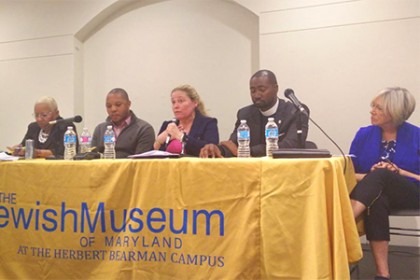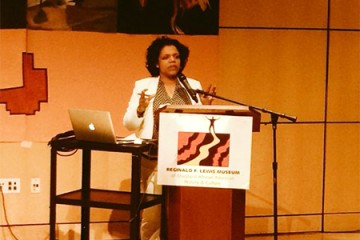"What would Baltimore look like if there was more equity?" asked Diane Bell-McKoy, president of Associated Black Charities, at a Redlining Baltimore conversation series event on Wednesday.

Image credit: Lavanya Madhusudan
For one, the city could see an additional $3.3 billion in revenue with an "economic renaissance" of African-Americans, Bell-McKoy's foundation has projected. She said she believes that goal is possible.
Panelists, moderated by JHU Carey Business School professor Lindsay Thompson, focused on wealth and opportunity in Baltimore—and the barriers to economic inclusion resulting from decades of discriminatory public policies known collectively as redlining. The speakers used a variety of other figures to illustrate these barriers.
Rodney Foxworth, founder and CEO of Invested Impact, a philanthropic enterprise focused on economic inclusion, noted that the U.S. loses $300 billion a year by not investing in minority-owned businesses.
Elisabeth Sachs, executive director of the Job Opportunities Task Force, discussed various obstacles for job seekers, including criminal records. She cited a study by a Princeton researcher that found that people with a criminal record were 50 percent less likely to get a callback or offer from an employer—but also that a white applicant with a criminal background had a higher chance of hearing back than a black applicant without one.
Bell-McKoy also cited a Pew study showing that the majority of Americans believe hard work is the primary determinant of success. She challenged that belief as a "fantasy" that fails to acknowledge the systemic obstacles to mobility that many people of color face.
"We still insist upon believing what's not true," she said.
Rev. Ramelle McCall of St. Michael and All Angels Episcopal Church narrowed in on one such obstacle—transportation. Growing up in West Baltimore, he endured epic commutes, sometimes two hours each way by bus and light rail, to attend a magnet arts high school and later Villa Julie College (now Stevenson University). He recalled "praying all the time" that buses would show up on time to get him to his morning classes.
As McCall told Places Journal last month, these journeys would give him a sweeping view Baltimore's contrasts, transitioning from urban poverty to manicured suburbia.
An audience member asked how to move from acknowledging inequalities—through discussions like the Redlining conversation series—to tackling them actively through policy reform.
Bell-McCoy said she did "question the seriousness" of that progress, noting the need for coalition-building.
"It requires strategic conversation we have yet to reach the level of," she said.
Foxworth addressed the issue of different groups having "a very different vision of what a better Baltimore looks like," with the danger of "people not really having the same conversation."
As Rev. McCall said of the night's event——a lot of city residents "would not even have time for this extremely wealthy conversation."
Last night's event, the third in the "Redlining Baltimore" series sponsored by Johns Hopkins University's 21st Century Cities Initiative, took place at the Jewish Museum of Maryland in Baltimore's Jonestown neighborhood. The fourth and final event, "Transform: The Future of Justice and Knowledge of the Redline," will be held May 4.
Posted in Voices+Opinion, Politics+Society
Tagged economy, baltimore, 21st century cities, redlining baltimore









